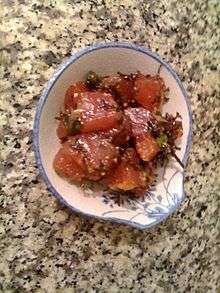Limu (algae)
Limu or Rimu is a general Polynesian term for edible plants living underwater, such as seaweed, or plants living near water, like algae.[1][2] In Hawaii, there are approximately one hundred names for kinds of limu, sixty of which can be matched with scientific names.[3] Hundreds of species or marine algae were once found in Hawaii.[4] Many limu are edible, and used in the cuisine throughout most of polynesia.

Uses
Alongside fish and poi, limu was seen as a major part of Native Hawaiian cuisine.[5] In ancient Hawaii, 75 types of limu were used for food, which is more than the 35 used in Japanese cuisine, which is also well-known for its use of seaweed.[4]
In modern times, limu are often used as a condiment and in raw fish dishes, such as poke.[6]
Limu was used in ho‘oponopono, the ancient Hawaiian process of conflict resolution. Injured and accused parties gathered to pray, seek forgiveness and eat limu kala leaves as a symbol of reconciliation.[6][7] It is also used in traditional hula attire[8] and as medicine.[9]
Types
Limu comes from multiple genera[5]
- Limu a ‘ele‘ele (Enteromorpha prolifera)
- Limu kala (Sargassum echinocarpum) – employed during ho‘oponopono.
- Limu koele – "dry or hard"[4]
- Limu a kohu (Asparagopsis taxiformis) – most popular
- Limu a huluhuluwaena (Grateloupia filicina or pubic hair) – favorite of Liliu‘okalani.[7]
- Limu hina (Hypnea sp.)
- Limu lipoa (Dictyopteris plagiogramma) – once found in almost continuous beds around O‘ahu. Disappeared from Waikiki Beach in the 1960s, crowded out by pollution and the invasive Gracilaria salicornia.
- Limu lo'loa (Gymnogongrous long or slender) [4]
- Limu a manauea (Gracilaria coronopifolia, ogo (Japanese)) – cooked with meats to form a savory jelly. Later diced raw with poke, mixed with chili and salt.[7]
- Limu palahalaha (Ulva fasciata) – used in hula[10]
- Limu a wawae‘iole (Codium edule)
- Pakaiea (green sea lettuce – named after a shark god who was swaddled in its silken leaves.[7]
- Lepelepe-o-Hina – shawl of the goddess Hina. Shares its name with a native butterfly and a family of nudibranchs.[7]
Threats
Limu has become increasingly difficult to find because of over-picking, pollution, and urban development,[11] especially construction in watersheds. Many important kinds of limu grow best in brackish water where fresh water empties into the sea. Another threat to limu is the spread of marine alien invasive species, such as members of the genus Kappaphycus (smothering seaweed), Graciliara salicornia (gorilla ogo), Avrainvillea amadelpha (leather mudweed), Hypnea musciformis (hook weed) and Acanthophora spicifera (prickly seaweed).[12]
See also
Further reading
- Abbott, Isabella Aiona (1992). Lā'au Hawai'i: Traditional Hawaiian Uses of Plants. Bishop Museum Press. ISBN 9780930897628.
- Abbott, Isabella Aiona; Huisman, John Marinus (2004). Marine Green and Brown Algae of the Hawaiian Islands. Bishop Museum Press. ISBN 9781581780307.
References
- "Seaweed, mosses and algae of polynesia". termarareo.org.
- "Nā Puke Wehewehe ʻŌlelo Hawaiʻi". wehewehe.org. Retrieved 2019-04-26.
- Aiona Abbott, Isabella. "Limu" (PDF). Retrieved 2008-09-05.
- MacCaughey, Vaughan (1916). "The Seaweeds of Hawaii". American Journal of Botany. 3 (8): 474–479. doi:10.1002/j.1537-2197.1916.tb05429.x. ISSN 0002-9122. JSTOR 2435240.
- "Edible Limu of Hawaii". www.hawaii.edu. Retrieved 2019-04-22.
- Spalding, Heather. "Got limu? Uses for algae in Hawaii and beyond" (PDF). University of Hawaii. Retrieved April 25, 2019.
- Wianecki, Shannon (2010-03-01). "The Lure of Limu". mauimagazine.net. Retrieved 2019-04-22.
- "New Algae Species Discovered in Hawaii's Deep Waters". www.papahanaumokuakea.gov. Retrieved 2019-04-26.
- Reed, Minnie (1907). Economic seaweeds of Hawaii and their food value. Washington, U.S. Government Printing Office.
- "Limu Palahalaha". Waikīkī Aquarium. 2013-11-11. Retrieved 2019-04-26.
- Hiraishi, Ku`uwehi. "Cultivating a Future for Hawaiian Seaweed". www.hawaiipublicradio.org. Retrieved 2019-04-26.
- "Invasive Algae". Aquatic Invasive Species. 2013-12-09. Retrieved 2019-04-22.
External links
- "The Limu Hui". KUA. 2016-02-02. Retrieved 2019-04-22.
- "Reef Watcher's Field Guide to Alien and Native Marine Algae". www.hawaii.edu. Retrieved 2019-04-22.